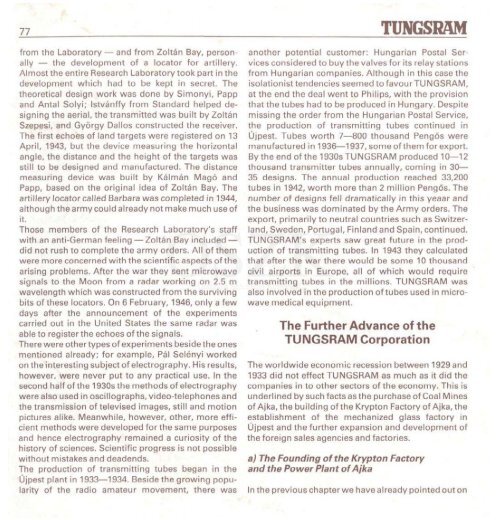THE HISTORY OF TUNGSRAM 1896-1945 - MEK
THE HISTORY OF TUNGSRAM 1896-1945 - MEK
THE HISTORY OF TUNGSRAM 1896-1945 - MEK
- No tags were found...
Create successful ePaper yourself
Turn your PDF publications into a flip-book with our unique Google optimized e-Paper software.
77 <strong>TUNGSRAM</strong>•'S „*'from the Laboratory — and from Zoltan Bay, personally— the development of a locator for artillery.Almost the entire Research Laboratory took part in thedevelopment which had to be kept in secret. Thetheoretical design work was done by Simonyi, Pappand Antai Soiyi; Istvanffy from Standard helped designingthe aerial, the transmitted was built by ZoltanSzepesi, and Gyorgy Dallos constructed the receiver.The first echoes of land targets were registered on 13April, 1943, but the device measuring the horizontalangle, the distance and the height of the targets wasstill to be designed and manufactured. The distancemeasuring device was built by Kalman Mago andPapp, based on the original idea of Zoltan Bay. Theartillery locator called Barbara was completed in 1944,although the army could already not make much use ofit.Those members of the Research Laboratory's staffwith an anti-German feeling — Zoltan Bay included —did not rush to complete the army orders. All of themwere more concerned with the scientific aspects of thearising problems. After the war they sent microwavesignals to the Moon from a radar working on 2.5 mwavelength which was constructed from the survivingbits of these locators. On 6 February, 1946, only a fewdays after the announcement of the experimentscarried out in the United States the same radar wasable to registerthe echoes of the signals.There were other types of experiments beside the onesmentioned already; for example. Pal Selenyi workedon the interesting subject of electrography. His results,however, were never put to any practical use. In thesecond half of the 1930s the methods of electrographywere also used in oscillographs, video-telephones andthe transmission of televised images, still and motionpictures alike. Meanwhile, however, other, more efficientmethods were developed for the same purposesand hence electrography remained a curiosity of thehistory of sciences. Scientific progress is not possiblewithout mistakes and deadends.The production of transmitting tubes began in theUjpest plant in 1933—1934. Beside the growing popularityof the radio amateur movement, there wasanother potential customer: Hungarian Postal Servicesconsidered to buy the valves for its relay stationsfrom Hungarian companies. Although in this case theisolationist tendencies seemed to favour <strong>TUNGSRAM</strong>,at the end the deal went to Philips, with the provisionthat the tubes had to be produced in Hungary. Despitemissing the order from the Hungarian Postal Service,the production of transmitting tubes continued inOjpest. Tubes worth 7—800 thousand Pengos weremanufactured in 1936—1937, some of them for export.By the end of the 1930s <strong>TUNGSRAM</strong> produced 10—12thousand transmitter tubes annually, coming in 30—35 designs. The annual production reached 33,200tubes in 1942, worth more than 2 million Pengos. Thenumber of designs fell dramatically in this yeaar andthe business was dominated by the Army orders. Theexport, primarily to neutral countries such as Switzerland,Sweden, Portugal, Finland and Spain, continued.<strong>TUNGSRAM</strong>'S experts saw great future in the productionof transmitting tubes. In 1943 they calculatedthat after the war there would be some 10 thousandcivil airports in Europe, all of which would requiretransmitting tubes in the millions. <strong>TUNGSRAM</strong> wasalso involved in the production of tubes used in microwavemedical equipment.The Further Advance of the<strong>TUNGSRAM</strong> CorporationThe worldwide economic recession between 1929 and1933 did not effect <strong>TUNGSRAM</strong> as much as it did thecompanies in to other sectors of the economy. This isunderlined by such facts as the purchase of Coal Minesof Ajka,the building of the Krypton Factory of Ajka, theestablishment of the mechanized glass factory inUjpest and the further expansion and development ofthe foreign sales agencies and factories.a) The Founding of the Krypton Factoryand the Power Plant of AjkaIn the previous chapter we have already pointed out on








![Letöltés egy fájlban [4.3 MB - PDF]](https://img.yumpu.com/50159926/1/180x260/letaltacs-egy-fajlban-43-mb-pdf.jpg?quality=85)







